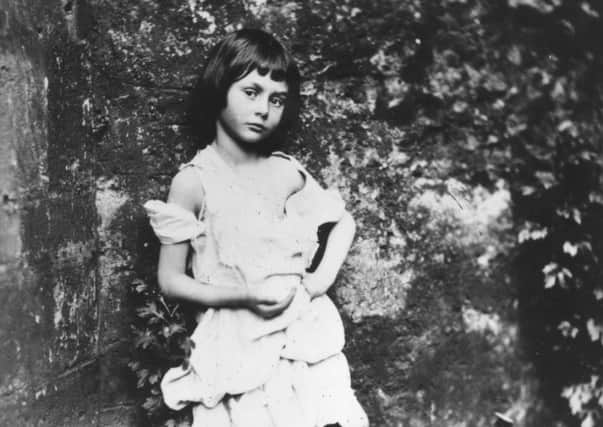Book review: The Story Of Alice by Robert Douglas-Fairhurst


The Story Of Alice
Robert Douglas-Fairhurst
Harvill Secker, £25
Both Alice’s Adventures In Wonderland – which was published 150 years ago – and Through The Looking Glass, And What Alice Found There are in that rare category of books (others might include Moby-Dick, A Christmas Carol and Gulliver’s Travels) that have entered the popular imagination so deeply that it is possible to know about them and recognise allusions to them without ever having read them.
To refresh the reader’s eyes into seeing the actual books again would be no mean achievement, but Robert Douglas-Fairhurst’s enlightening and endlessly fascinating The Story Of Alice is actually four books at once; a very Alice-like proposition in itself. It is a biography of the Rev Charles Dodgson, known to the outside world as Lewis Carroll. It is a biography of Alice Liddell, the little girl who inspired his first attempt at the story, and who was the subject of many of his photographs. It is the story of what it is like to read the Alice books, and an account of the imitations and parodies, plays and films it spawned, as well as novelties like the “Wonderland Postage Stamp Case”, invented by Carroll, and a type of hair band derived from Tenniel’s illustrations rather than Carroll’s text.
Advertisement
Hide AdAlice Liddell grew old – sitting for Julia Cameron and some Pre-Raphaelite paintings – before marrying and settling down in a Georgian home, Cuffnells. In later life she slightly traded on her association with the books, mostly at the promptings of her son, curiously called Caryl. Carroll continued his life at Christ Church. Douglas-Fairhurst brilliantly compares his duties as Curator of the Common Room with Alice’s domestic management elsewhere.
As a don, he continued his academic work. There is a hilarious moment when, as per Queen Victoria’s request, Carroll purportedly sends her a bound copy of his next book, An Elementary Treatise On Determinants: With Their Application To Simultaneous Linear Equations And Algebraical Geometry. His life filled with a large number of “child-friends”, a staggering number of whom were called Alice.
Douglas-Fairhurst provides the best readings of the Alice books I have come across. The American critic Susan Sontag, in her essay Against Interpretation, argued about the “erotics” rather the “hermeneutics” of a piece of writing. There are plenty of concordances and annotated editions that strive to show how the Hatter is a symbol for something, the Mock-Turtle a metaphor for something else and the White Knight a thinly-veiled version of so-and-so. This is what Douglas-Fairhurst does not do. He shows how the books pleasurably flummox and misdirect, how they joyfully evade meaning. He does not do this without academic rigour. He is exhaustive on precedents for underground worlds and the failings of latter homages.
Little seems to escape his notice. For example, all the chief players in the story of the composition of Alice refer to a “golden afternoon” punting under blazing heat. From the meteorological offices, Douglas-Fairhurst discovers the day was “cool and rather wet” with complete cloud cover. A story told often enough will supplant the truth: again, the kind of insight that would come from Wonderland rather than the academy.
Any mention of “erotics” brings up the key question: what was the relationship between Alice and Carroll? Douglas-Fairhurst is here scrupulous. The relevant pages concerning the breach with the Liddells were removed from Carroll’s diary. There was a Victorian culture of kissing, of idealising and even of artistic nudity which seemed to them morally uplifting but makes us squirm. Then there are the photographs of Alice, with her strange sulkiness. The photographs, like the books, fix the child in an eternal present.
But there are other comparisons to be drawn. Christopher Robin Milne deeply resented his transformation in Winnie-the-Pooh. Peter Llewellyn Davies, the model for Peter Pan, committed suicide, as did Kenneth Grahame’s son Alastair – whose temper tantrums were given to Mr Toad in Wind In The Willows. By contrast, Alice seems to have had a happy marriage and was content, to an extent, to be known as the inspiration. In our culture, there seems to be an increase in sexualised versions of the Alice story: numerous pornographic adaptations and at least one work of genius, AM Homes’ intensely troubling novel, The End Of Alice, and Alan Moore’s graphic novel, Lost Girls. As with the world of mirrors she encounters in the books, it might be that what is seen depends on the curvature of our culture, not her intrinsic likeness.
Advertisement
Hide AdThis book has many ingenious asides, and I found a turn of phrase that was eyebrow-raisingly elegant on every other page. It plays its own games: Carroll was obsessed with the number 42, and so we have 42 chapters, with the size copying Alice’s changeable shape, and a homage to his typographic peculiarities. But above all it detects beneath the surface of logical puzzles and an imagination that was always the better for being fettered a deep melancholy within the books. They are works full of interruptions, of stories cut short, of an omnipresent danger. This seems astute: Wonderland is not a nice, fey place, but a zone of interrogations and threats, perils and sudden, meaningless changes. There is the very surprising use of Alice in First World War literature, such as Journey’s End. But then, as Douglas-Fairhurst notes, the Cheshire Cat had pre-empted the idea that we’re all mad here. The reader will need to wait until the acknowledgements to discover why Douglas-Fairhurst might see the Alice texts that way.
The Story Of Alice is none the less a sprightly read, with curiouser and curiouser facts throughout. It returns the reader to the books, and in doing so performs an inestimable service to the author, his inspiration and legions of readers.